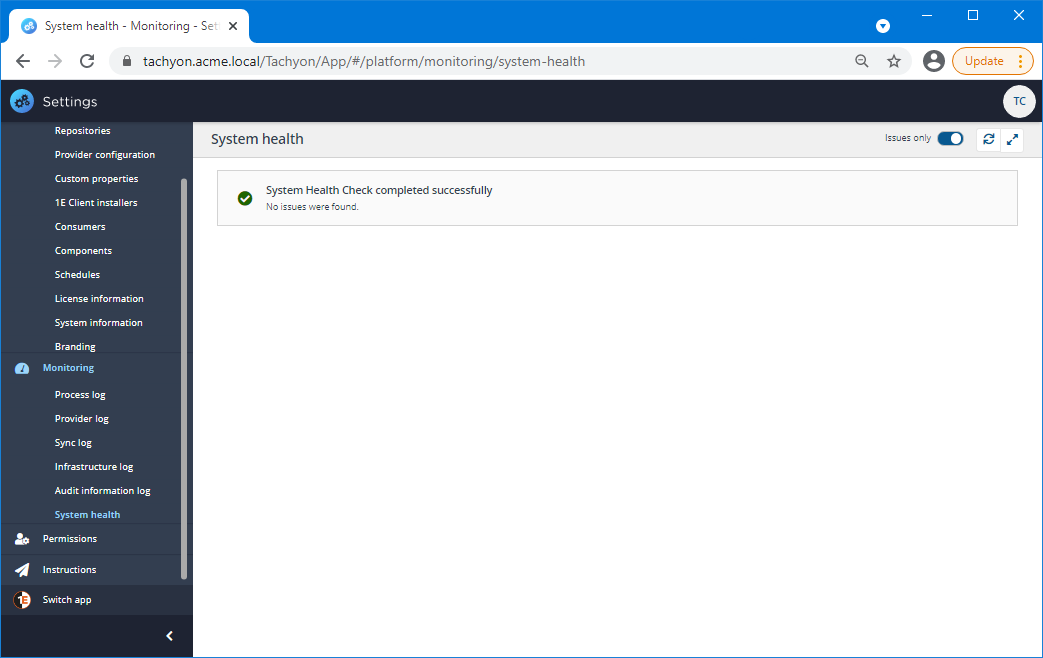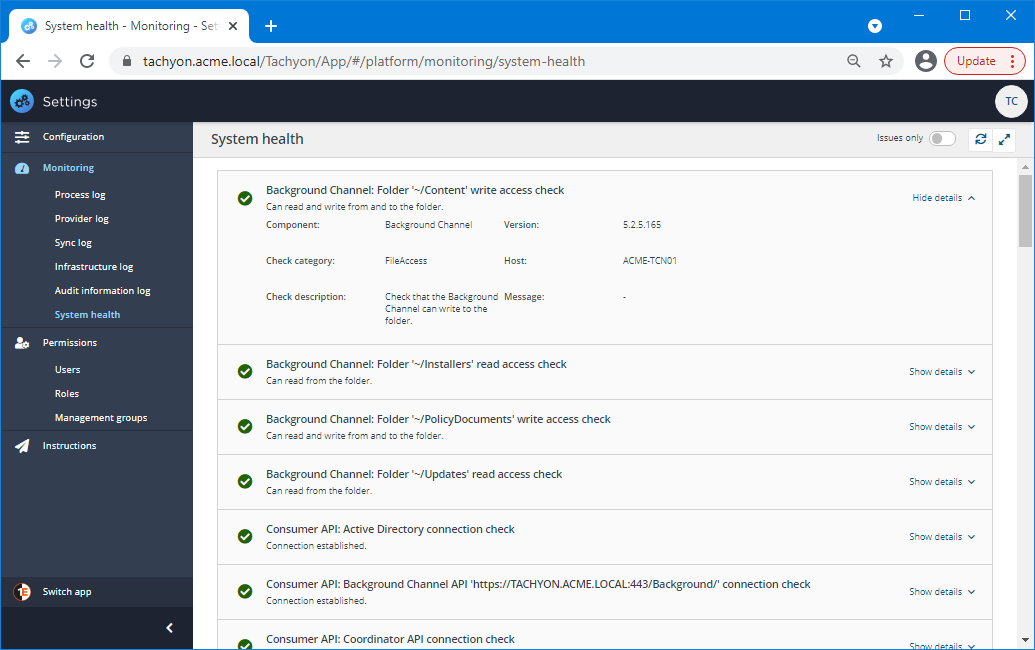System health page
The System Health page runs a comprehensive series of component checks. By default, it shows issues, but you can see a full list of green lights by toggling Issues only.

Looking at the health checks
Showing all the checks
By default, the System health page shows only the checks where issues have been identified, unless there are no issues, in which case it displays an all clear message. You can set the page to show all the checks by toggling the Issues only switch to off in the banner for the page. The picture shows this and the types of check that will be subsequently displayed.
Showing the check details
You can also expand each check to view the details related to it by clicking on the Show details link at the top-right of the check's entry in the System health table. The picture shows the Background Channel Folder write access check expanded.
When expanded you can see the following information for each check:
Information | Description |
|---|---|
Component | The name for the component. |
Version | The component version number. |
Check category | The category the check belongs to. |
Host | The host device the component is running on. |
Check description | The description for the check being made. |
Message | Any messages that have been generated by running the check. |
Note
You will see four SLA Integrate errors after installation, which will disappear after you have installed a Connector.

The health checks
The following table provides an overview of all the health checks made by Tachyon:
Component | Check | Description |
|---|---|---|
Folder '~/Content' write access check | Check that the Background Channel can write to the "Content" folder within the app pool user context. | |
Folder '~/Installers' read access check | Check that the Background Channel can read from the "Installers" folder within the app pool user context. | |
Folder '~/Policy Documents' write access check | Check that the Background Channel can write to the "PolicyDocuments" folder within the app pool user context. | |
Folder '~/Updates' read access check | Check that the Background Channel can read from the "Updates" folder within the app pool user context. | |
Active Directory connection check | Check that Consumer API can connect to Active Directory. Uses the configured GC or LDAP connection string. | |
Background Channel API connection check(s) | Check that Consumer API can connect to Background Channel API. Uses the URL(s) stored in the TachyonMaster database. | |
Coordinator API connection check | Check that Consumer API can connect to Coordinator API. Uses the OperationalSafeGuardsUrl application setting. | |
Core API '<Core server>' connection check(s) | Check that Consumer API can connect to Core API. Uses the URL(s) stored in the TachyonMaster database. | |
TachyonMaster database connection check | Check that Consumer API can connect to the TachyonMaster database. Uses the configured connection string (TachyonMaster) within the app pool user context. | |
TachyonResponse database connection check(s) | Check that Consumer API can connect to the TachyonResponse database(s). Uses the stored connection strings within the TachyonMaster database under the app pool user context. | |
Background Channel API connection check | Check that Coordinator Agent Deployment module can connect to Background Channel API. Uses the URL(s) stored in the TachyonMaster database. | |
Check license service URL | Verify that license service URL is from a trusted issuer. | |
Check license validity | Verify license expiry date. | |
Check trust with licensing component | Verify trust between coordinator and licensing component by comparing signatures between the licensing module DLL and licensing DLL. | |
Management Group API connection check | Check that Coordinator Management Groups module can connect to SLA Management Group API using the configured URL. Uses the SLAEndpoint module setting. | |
Background Channel API connection check | Check that Coordinator Policy Module can connect to Background Channel API. Uses the URL(s) stored in the TachyonMaster database. | |
Active Directory connection check | Check that Coordinator can connect to Active Directory. Uses the configured GC or LDAP connection string. | |
Coordinator certificate check | Check that Coordinator has a valid certificate used for the SSL API communication. | |
SMTP connection check | Check that Coordinator can connect to the SMTP server using the "EHLO" command. Only shown if SMTP emails has been enabled. | |
TachyonMaster database connection check | Check that Coordinator can connect to the TachyonMaster database. Uses the configured connection string (TachyonMaster) within the app pool user context. | |
Website application authentication check | Check that Consumer API site has Windows authentication enabled and that Anonymous authentication is disabled. | |
Website certificate binding check | Check that Consumer API has a valid certificate binding. | |
TachyonMaster database connection check | Check that Core can connect to TachyonMaster database. Uses the configured connection string (TachyonMaster) within the app pool user context. | |
TachyonResponse database connection check(s) | Check that Core can connect to TachyonResponse database(s). Uses the stored connection strings within the TachyonMaster database under the app pool user context. | |
Consumer API connection check | Check that SLA Admin can connect to the Consumer API. Uses the PermissionCheckerRootUrl application setting. | |
SLA Platform API connection check | Check that SLA Admin can connect to the SLA Platform API. | |
SLA-Data database connection check | Check that SLA Admin can connect to the SLA-Data database. Uses the configured connection string (DefaultCustomerConnection) within the app pool user context. | |
SLA-Shared database connection check | Check that SLA Admin can connect to the SLA-Shared database. Uses the configured connection string (DefaultSharedConnection) within the app pool user context. | |
1ECatalog database connection check | Check that SLA Engine can connect to the 1ECatalog database. Uses the BaseUri application setting to request the 1ECatalog connection string from the SLA Platform API. The database connection check is performed within the service user context. | |
Catalog API connection check | Check that SLA Engine can connect to the Catalog API. Uses the URL retrieved from the SLA-Data.Component table for 1ECatalog within the service user context. | |
Consumer API connection check | Check that SLA Engine can connect to the Consumer API. Uses the TachyonConsumerRootUrl application setting. | |
SLA Platform API connection check | Check that SLA Engine can connect to the SLA Platform API. Uses the BaseUri application setting. | |
SLA-Data database connection check | Check that SLA Engine can connect to the SLA-Data database. Uses the configured connection string (DefaultCustomerConnection) within the service user context. | |
SLA-Shared database connection check | Check that SLA Engine can connect to the SLA-Shared database. Uses the configured connection string (DefaultSharedConnection) within the service user context. | |
(part of SLA Integrate services) | Folder '<ConnectorsRoot>' write access check | Check the SLA Integrate Agent can write to the 'dir-connectors' folder within the service user context. |
Folder '<InstallerRoot>' write access check | Check the SLA Integrate Agent can write to the 'dir-job-output' folder within the service user context. | |
Folder '<JobOutputRoot>' write access check | Check the SLA Integrate Agent can write to the 'dir-job-output' folder within the service user context. | |
SLA Integrate Manager connection check | Check that the SLA Integrate Agent can connect to the SLA Integrate Manager. Uses the rest-api-address application setting. | |
SLA Platform API connection check | Check that the SLA Integrate Agent can connect to the SLA Platform API. Uses the rest-api-address application setting to request the SLA Platform API address from the SLA Integrate Manager. | |
(part of SLA Integrate services) | Folder '<InstallerRoot>' write access check | Check the SLA Platform Integrate Manager can write to the 'dir-installers' folder within the service user context. |
Folder '<JobOutputRoot>' write access check | Check the SLA Platform Integrate Manager can write to the 'dir-job-output' folder within the service user context. | |
SLA Platform API connection check | Check that SLA Integrate Manager can connect to the SLA Platform API. Uses the sla-data-address application setting. | |
SLA-Integrate database connection check | Check the SLA Integrate Manager service can connect to the SLA-Integrate database. Uses the configured connection string (default) within the service user context. | |
SLA Platform Integrate Agent | Check at least one SLA Platform Integrate Agent has reporting health status. | |
API includes the UI The following are not checked:
| 1ECatalog database connection check | Check that SLA Platform API can connect to the 1ECatalog database. Uses the configured connection string (DefaultCatalogConnection) within the app pool user context. |
Consumer API connection check | Check that SLA Platform API can connect to Consumer API. Uses the PermissionCheckerRootUrl application setting. | |
SLA-Data database connection check | Check that SLA Platform API can connect to the SLA-Data database. Uses the configured connection string (DefaultCustomerConnection) within the app pool user context. | |
SLA-Shared database connection check | Check that SLA Platform API can connect to the SLA-Shared database. Uses the configured connection string (DefaultSharedConnection) within the app pool user context. | |
SLA Engine | Check the SLA Engine has reported health status. | |
Switch Host is not checked | Core Connect (Device) | Check if this Switch can connect to core Device endpoint. |
Core Connect (Instructions) | Check if this Switch can connect to core Instructions endpoint. | |
Core Connect (Policy Response) | Check if this Switch can connect to core Policy Response endpoint. | |
Core Connect (Policy) | Check if this Switch can connect to core Policy endpoint. | |
Core Connect (Response) | Check if this Switch can connect to core Response endpoint. | |
Core Connect (Switch) | Check if this Switch can connect to core Switch endpoint. | |
Recent administrative events. | Check if this Switch has had any recent errors or warnings (since last instruction poke) |